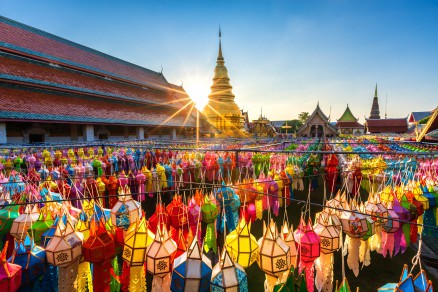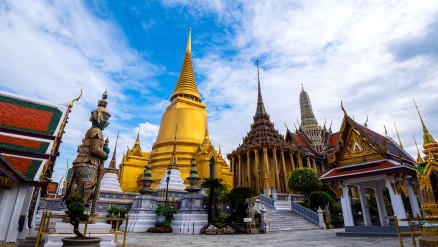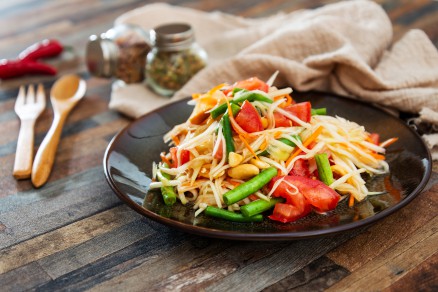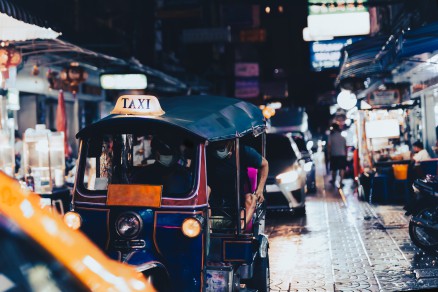
Ultimate Thailand Travel Guide: Your Gateway to the Land of Smiles

Thailand, famously known as the “Land of Smiles,” is one of Southeast Asia’s most beloved travel destinations. This Thailand travel guide will take you through a spectacular blend of ancient traditions, bustling modern cities, serene islands, and diverse landscapes. Whether you’re an adventure seeker trekking through northern jungles, a beach lover lounging on the shores of Phuket, a culture enthusiast exploring ornate temples, or a foodie sampling street food in Bangkok, Thailand provides something unforgettable for every traveler.
Why Visit Thailand?
This Thailand travel guide highlights why the country stands out for its affordability and accessibility. Visitors can enjoy everything from luxury resorts to simple guesthouses at pocket-friendly prices. The warm and welcoming locals add a personal touch, making travelers feel safe and appreciated. The country’s cultural richness — from grand Buddhist temples to colorful festivals — adds unforgettable depth to every visit.
Few places in the world offer such a wide range of experiences within one destination, and this Thailand travel guide is here to help you discover them. Whether you’re trekking through misty northern mountains, relaxing on palm-fringed southern beaches, or diving into the energy of Bangkok’s vibrant city life, Thailand has something for everyone. The Thai people’s renowned hospitality ensures that even first-time visitors feel welcomed from the moment they arrive.
Best Time to Visit

The best time to explore Thailand is during the cool season, which spans from November to February. This period is considered the most comfortable and traveller-friendly, with pleasant daytime temperatures, lower humidity, and minimal rainfall across most regions of the country. It’s an ideal time to explore vibrant cities like Bangkok, visit ancient temples in Ayutthaya or Chiang Mai, and enjoy cultural festivals such as Loy Krathong and Yi Peng, where thousands of lanterns light up the night sky. The cool, dry weather also makes it perfect for trekking in the northern mountains or relaxing on Thailand’s famous beaches in Phuket, Krabi, and Koh Samui.
From March to May, Thailand enters the hot season, when temperatures can soar above 35°C (95°F), especially in inland cities. While the heat can be intense, it’s also a great time for island hopping, water sports, and diving adventures. Destinations like the Similan Islands and Koh Tao offer clear waters and stunning marine life during this time. The Thai New Year, known as Songkran, is celebrated in mid-April with nationwide water fights that offer both cultural insight and a welcome relief from the heat.
The rainy season, from June to October, is marked by tropical monsoon showers, which usually occur in the late afternoon or evening. While the weather can be unpredictable, it rarely rains all day, and mornings are often sunny. This season transforms the landscape into a lush, green paradise, making it a beautiful time for photographers and nature lovers. Waterfalls are at their most powerful, rice paddies glow with life, and national parks are thriving with flora and fauna. Plus, fewer tourists during the rainy months mean you can enjoy major attractions without the crowds and benefit from lower accommodation prices and off-season travel deals.
Each season in Thailand has its own unique charm and perks. Whether you’re after cultural festivals, beach adventures, outdoor activities, or a quiet retreat, this Thailand travel guide will help you pick the best time to visit based on the weather. It’s also good to keep in mind that the climate can vary by region — for instance, while Phuket might be wet during the rainy season, Koh Samui on the Gulf Coast often stays dry, making it a great alternative. With a little planning, you can enjoy everything Thailand has to offer no matter when you go.
In short, Thailand is a year-round destination, and with a little planning, you can enjoy its many wonders at any time of year.
How to Get There and Around
Bangkok’s Suvarnabhumi Airport is the main international gateway, with direct flights from most continents. Other international airports include Phuket, Chiang Mai, and Krabi, providing convenient access depending on your itinerary.
Getting around Thailand is easy with numerous transport options. Domestic flights are affordable and quick, connecting major cities and islands. Trains provide a scenic and comfortable way to explore northern and southern routes. Buses and minivans are common for short distances. In cities, tuk-tuks and motorbike taxis offer fun and authentic ways to travel, while Grab (a rideshare app) ensures hassle-free trips.
Top Destinations

- Bangkok: A chaotic yet fascinating city famous for the Grand Palace, Wat Pho, vibrant street markets, and diverse cuisine.
- Chiang Mai: A cultural hub in the north known for its temples, hill tribe villages, and peaceful atmosphere.
- Phuket: Thailand’s largest island, offering beautiful beaches, lively nightlife, and great diving spots.
- Krabi & Ao Nang: Known for stunning limestone cliffs, clear waters, and adventure activities like rock climbing and kayaking.
- Pai: A quiet mountain town perfect for relaxation, hot springs, and exploring nature trails.
Must-Try Thai Food

Thai cuisine is world-renowned for its vibrant flavours, masterfully balancing sweet, sour, salty, and spicy elements in each dish. With a culinary tradition deeply rooted in fresh ingredients and time-honoured cooking techniques, Thailand offers a gastronomic experience that delights every palate — from first-time visitors to seasoned food lovers.
Among the must-try dishes is the iconic Pad Thai, a stir-fried noodle dish commonly made with shrimp, tofu, peanuts, and a splash of tamarind sauce — a favourite among locals and tourists alike. Tom Yum Goong, the famous hot and sour shrimp soup, packs a punch with lemongrass, galangal, chilli, and lime leaves, offering a perfect balance of heat and citrusy zing. Green Curry (Gaeng Keow Wan), made with coconut milk, Thai basil, and green chilli paste, is rich, creamy, and aromatic, often served with jasmine rice.
Another staple is Som Tum, a fiery green papaya salad that combines shredded papaya with garlic, tomatoes, green beans, peanuts, fish sauce, and a generous squeeze of lime — refreshing, crunchy, and surprisingly addictive. For dessert, nothing beats Mango Sticky Rice (Khao Niew Mamuang), a comforting blend of ripe mango, sweetened sticky rice, and warm coconut cream — especially during mango season.
One of the best ways to experience Thai food is through its legendary street food scene. From bustling night markets in Bangkok to beachside vendors in Phuket and Chiang Mai’s walking streets, street food stalls offer authentic, affordable, and surprisingly safe meals. Dishes like grilled satay skewers, spicy sausages, banana pancakes, and fresh fruit smoothies can be found at nearly every corner, allowing travellers to eat like a local and discover new favourites with each bite.
Thai cuisine is not just about taste — it’s a cultural expression. Meals are often shared, encouraging conversation and connection, and regional variations offer unique twists. In the north, dishes like Khao Soi (a creamy curry noodle soup) are popular, while the southern region favours rich, spicy curries and fresh seafood dishes influenced by Malay and Indian flavours.
Budgeting Your Trip
Thailand is known for being budget-friendly, but costs can vary depending on the region and your travel style. According to this Thailand travel guide, backpackers can comfortably get by on around $20–30 USD per day, while those looking for a bit more comfort might spend between $50 and $100 USD daily. For luxury travelers, there are plenty of 5-star resorts and private tours available without breaking the bank. Just be sure to budget a little extra for special activities like diving, cultural shows, and guided tours to make the most of your trip.
Travel Scams and Safety Tips
While Thailand is generally safe, common tourist scams exist. Beware of tuk-tuk drivers offering “special tours” at inflated prices or gem scams promising unbeatable deals. Always negotiate fares in advance and use official ticket counters for attractions. Keep an eye on your belongings in crowded areas, and avoid overly friendly strangers offering unsolicited help.
Sample 7-Day Itinerary
- Day 1-2: Explore Bangkok’s temples, markets, and nightlife.
- Day 3-4: Fly to Chiang Mai; visit temples, attend a cooking class, and explore nearby waterfalls.
- Day 5-7: Head south to Phuket or Krabi for beach time, island tours, and water sports.
This mix of city, culture, and nature showcases the best of Thailand’s diversity.
Nightlife and Entertainment

Thailand’s nightlife is legendary, offering an unforgettable mix of excitement, culture, and atmosphere that caters to all tastes and travel styles. In Bangkok, the experience begins high above the city at glamorous rooftop bars like Vertigo or Sky Bar, where panoramic views of the skyline meet creative cocktails and a stylish crowd. Down at street level, lively night markets such as Asiatique and Rot Fai Market burst into action after sunset, serving everything from sizzling street food and cold Thai beers to quirky souvenirs and vintage fashion.
For those looking to immerse themselves in cultural entertainment, traditional Thai dance performances held at venues like Sala Rim Naam or Siam Niramit offer a glimpse into the country’s rich heritage, complete with ornate costumes and dramatic storytelling. Muay Thai boxing matches, often held in stadiums or tourist-friendly arenas, combine sport, ritual, and raw energy — a must-see for those seeking authentic local experiences.
Wellness and Retreats
Thailand is a top destination for wellness tourism. Many travelers come for yoga retreats, meditation centers, and traditional Thai massage. Regions like Chiang Mai and Koh Samui have numerous spas and holistic health resorts offering detox and relaxation programs.
Cultural Etiquette
Respecting Thai customs enriches your experience. Dress modestly when visiting temples, remove shoes before entering homes or sacred places, and always greet with a “wai” (a slight bow with palms pressed together). Avoid touching anyone’s head and never point your feet at people or Buddha images, as these are considered disrespectful.
Connectivity and SIM Cards
Stay connected easily with local SIM cards from providers like AIS, DTAC, or TrueMove. SIM cards are available at airports and convenience stores at affordable prices and include generous data packages.
What to Pack
Lightweight, breathable clothing is essential due to the tropical climate. Pack modest outfits for temple visits, comfortable walking shoes, swimwear, sunscreen, insect repellent, and a reusable water bottle. A power bank and universal adapter are handy for long travel days.
Useful Thai Phrases
Learning simple Thai greetings and phrases will endear you to locals. Start with “Sawasdee” (hello), “Khop khun” (thank you), and “Mai phet” (not spicy). Locals appreciate any effort to speak their language and will often respond warmly.
Responsible Travel
Protecting Thailand’s natural beauty and culture is important. Avoid plastic waste by carrying refillable bottles, support local businesses, choose ethical animal sanctuaries over tourist exploitative attractions, and respect marine environments by using reef-safe sunscreen.
Final Thoughts
Thailand is a destination that truly has something for everyone. Its combination of affordability, cultural richness, natural beauty, and hospitality make it a must-visit spot in Asia. Whether you stay for a week or a month, the experiences you gather—from ancient temples to tropical islands—will stay with you forever.

